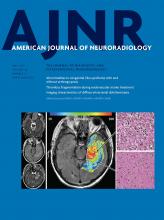Research ArticleAdult Brain
Open Access
Ipsilateral Prominent Thalamostriate Vein on Susceptibility-Weighted Imaging Predicts Poor Outcome after Intravenous Thrombolysis in Acute Ischemic Stroke
X. Zhang, S. Zhang, Q. Chen, W. Ding, B.C.V. Campbell and M. Lou
American Journal of Neuroradiology May 2017, 38 (5) 875-881; DOI: https://doi.org/10.3174/ajnr.A5135
X. Zhang
aFrom the Departments of Neurology (X.Z., S.Z., Q.C., M.L.)
S. Zhang
aFrom the Departments of Neurology (X.Z., S.Z., Q.C., M.L.)
Q. Chen
aFrom the Departments of Neurology (X.Z., S.Z., Q.C., M.L.)
W. Ding
bRadiology (W.D.), the Second Affiliated Hospital of Zhejiang University, School of Medicine, Hangzhou, China
B.C.V. Campbell
cDepartment of Neurology (B.C.V.C.), Royal Melbourne Hospital, Grattan St, Parkville, Victoria, Australia.
M. Lou
aFrom the Departments of Neurology (X.Z., S.Z., Q.C., M.L.)

REFERENCES
- 1.↵
- 2.↵
- 3.↵
- 4.↵
- 5.↵
- 6.↵
- 7.↵
- 8.↵
- Fujioka M,
- Okuchi K,
- Iwamura A, et al
- 9.↵
- 10.↵
- 11.↵
- 12.↵
- 13.↵
- Jung S,
- Gilgen M,
- Slotboom J, et al
- 14.↵
- DeLong MR,
- Alexander GE,
- Mitchell SJ, et al
- 15.↵
- Mink JW,
- Thach WT
- 16.↵
- Wichmann T,
- DeLong MR
- 17.↵
- Cheng B,
- Forkert ND,
- Zavaglia M, et al
- 18.↵
- Hermier M,
- Nighoghossian N,
- Derex L, et al
- 19.↵
- 20.↵
- 21.↵
- 22.↵
- Oh MY,
- Ko SB,
- Kim CK, et al
- 23.↵
- 24.↵
- 25.↵
- Bang OY,
- Saver JL,
- Buck BH, et al
- 26.↵
- 27.↵
- 28.↵
- 29.↵
- Berkhemer OA,
- Fransen PS,
- Beumer D, et al
- 30.↵
In this issue
American Journal of Neuroradiology
Vol. 38, Issue 5
1 May 2017
Advertisement
X. Zhang, S. Zhang, Q. Chen, W. Ding, B.C.V. Campbell, M. Lou
Ipsilateral Prominent Thalamostriate Vein on Susceptibility-Weighted Imaging Predicts Poor Outcome after Intravenous Thrombolysis in Acute Ischemic Stroke
American Journal of Neuroradiology May 2017, 38 (5) 875-881; DOI: 10.3174/ajnr.A5135
0 Responses
Ipsilateral Prominent Thalamostriate Vein on Susceptibility-Weighted Imaging Predicts Poor Outcome after Intravenous Thrombolysis in Acute Ischemic Stroke
X. Zhang, S. Zhang, Q. Chen, W. Ding, B.C.V. Campbell, M. Lou
American Journal of Neuroradiology May 2017, 38 (5) 875-881; DOI: 10.3174/ajnr.A5135
Jump to section
Related Articles
- No related articles found.
Cited By...
This article has not yet been cited by articles in journals that are participating in Crossref Cited-by Linking.
More in this TOC Section
Similar Articles
Advertisement











